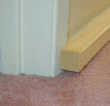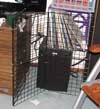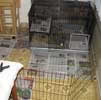
Get Ready Before you Adopt
Humans need to properly prepare their houses to accommodate the natural behavior of rabbits. Without safeguards, it's like bringing a chewing & digging machine in your house. Without protecting your environment, it is dangerous for the rabbit and you will be unhappy with the destruction they can cause. You will not appreciate their curiosity and energy under these circumstances.
It is possible to limit damage by limiting rabbit access, but you will not get the most possible out of your relationship with your rabbit.
Rabbit Proofing
Rabbits are talented & persistent chewers & diggers by nature. They have evolved to be very good at this & pursuing these activities compose a large part of their psychological profile. Females typically maintain the warren in the wild and they are the most likely to dig. All rabbits enjoy the taste and texture of many different materials. Younger rabbits are especially eager to experience the world by this sensory perception. Older rabbits, who have tasted it all, are less active chewers. It is impossible to train a rabbit to completely stop these activities. Disciplining is not a reliable training method. The best thing to do is to give your rabbit healthy, non-destructive and non-dangerous outlets for these behaviors. The following items are suggestions to distract them & give them alternatives to nibbling on things you want to keep.
Click on the pictures for an enlarged view of the material.
These stores have split loom tubing and or spiral wrap of various diameters:
Orchard Supply Hardware, Radio Shack, Fry's, IKEA, Home Depot.
Housing
Rabbits can live in a cage or enclosed area. You can section off a part of your room with an exercise pen. Often we start the rabbits out in cages, then give them more space in an enclosed area when they are litter trained so they have more room to relax & exercise. The cage becomes the "nest" where they can retreat & call their own. You may need to confine or separate your rabbit from your other pets or rabbits for medical or behavior issues and the cage becomes a protective shell for you and your rabbit.
Often people will have just an exercise pen with their rabbit supplies without a cage.
Litter
Rabbits are easily litter trained & this makes them enjoyable pets. However, their litter needs are different from cats. Be sure to avoid clumping cat litter for rabbits. Rabbits may ingest the clumping litter & cause intestinal blockages. The dust will also interfere with their respiratory system. Do not use aromatic wood shaving such as pine or cedar. These have oils which release gasses that have been shown to damage rabbit's livers. We recommend paper or sawdust-based media such as "Yesterday's News", Stall Pellets for horses, or wood stove pellet fuel. These are all biodegradable & are are excellent mulch for your garden.














